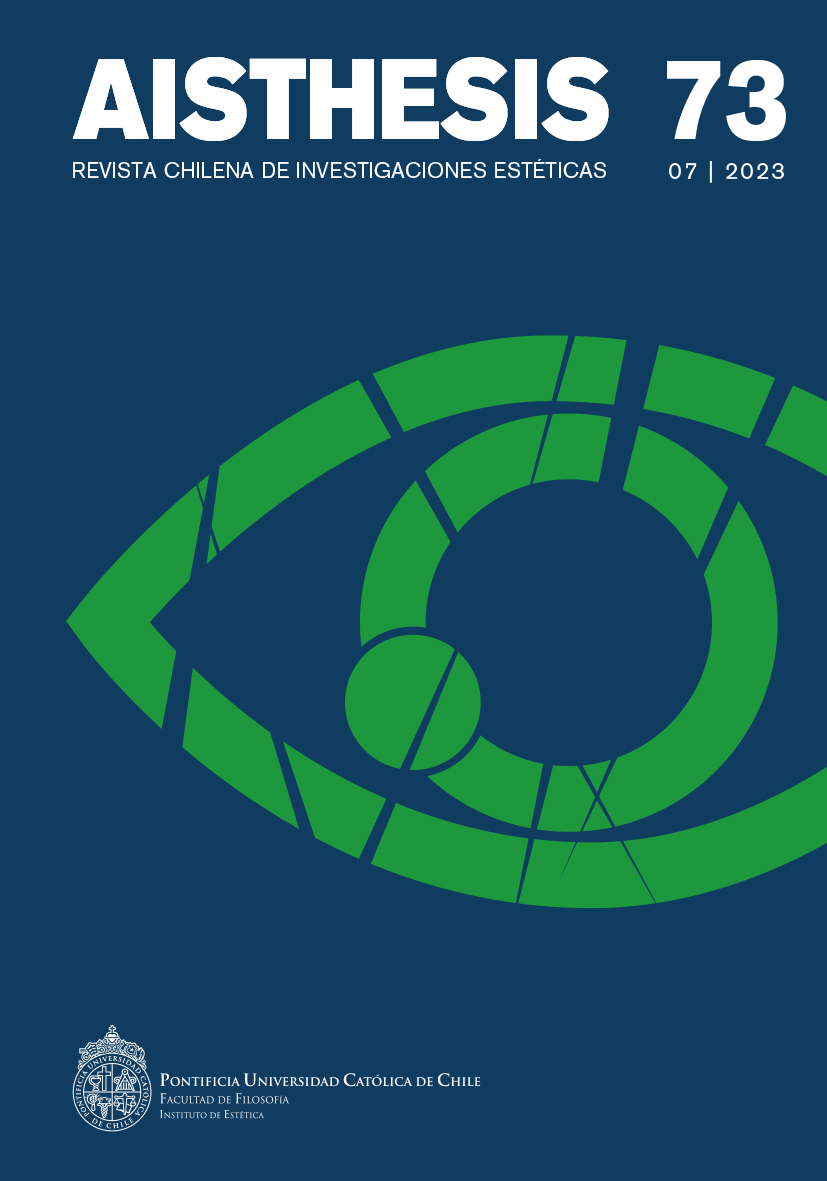Weavers in the Dark (Knitting a Cosmic Symphony): Notes on the Arachnid Work of Tomás Saraceno
Main Article Content
Abstract
This article examines the work with arachnids of artist Tomás Saraceno, regarding its affinity with the philosophical ideas emerged in the context of the non-human turn in contemporary thought. Beginning with «Galaxies Forming along Filaments», followed by «Hybrid Webs», «Cosmic Jives», and «Arachnid Orchestra», three phases of an inductive process–reticular, hybrid, and bioacoustics–are proposed, whereby the artist has progressively collapsed the hierarchy between the knowledges that merge in this artistic creation. Through the analysis of the progressive mode in which these phases call for the reconsideration of notions such as agency, poiesis, and technique in art, this article proposes that what is at issue in this process is a movement toward an ethic of objects without hierarchy. This work with spiders, then, sketches an axiology that inverts the formal universe so as to liberate artistic creation from human and visual predominance through symbiotic work.
Downloads
Article Details

This work is licensed under a Creative Commons Attribution-NonCommercial-ShareAlike 4.0 International License.
All contents of this electronic edition are distributed under the Creative Commons license of "Attribución-shareAlike 4.0 Internacional" (CC-BY-SA). Any total or partial reproduction of the material must mention its origin.
The rights of academic works published in this publication belong to their authors., who grant to AISTHESIS: Revista Chilena de Investigaciones Estéticas the license for its use. The management of the permits and the authorization of the publication of the images (or of any material) that contains copyright and its consequent rights of reproduction in this publication is the sole responsibility of the authors of the articles
References
Bataille, Georges. «L’informe». Documents: doctrines, archéologie, beaux-arts, ethnographie: magazine illustré paraissant dix fois par an, vol. 1. Bibliothèque Nationale de France, 1929. https://gallica.bnf.fr/ark:/12148/bpt6k32951f/f509
Bauer, Ute Meta y Anca Rujoiu. Arachnid Orchestra: Jam Sessions. NTU Centre for Contemporary Art Singapore, 2016.
Bond, J. Richard, Lev Kofman y Dmitri Pogosyan. «How Filaments are Woven into the Cosmic Web», 1995. Luego publicado en Nature, vol. 380, nº 6.575, 1996, pp. 603-606.
Bois, Yve Alain y Rosalind E. Krauss. Formless: A User’s Guide. Zone Books, 1997.
Brasier, Martin D, Laura Cotton e Ian Yenney. «First Report of Amber with Spider Webs and Microbial Inclusions from the Earliest Cretaceous (c. 140 Ma) of Hastings, Sussex». Journal of the Geological Society, vol. 166, nº 6, 2009, pp. 989-997.
Dawkins, Richard. The Extended Phenotype: The Gene as the Unit of Selection. W. H. Freeman and Company, 1982.
Duchamp, Marcel. «Apropos of Readymades». The Essential Writings of Marcel Duchamp. Ed. Michel Sanouillet y Elmer Peterson. Thames and Hudson, 1975.
Engelmann, Sasha. «Social Spiders and Hybrid Webs at Studio Tomás Saraceno». Cultural Geographies, vol. 24, nº I, 2017. pp. 161-169.
Ferreter Mora, José. Diccionario de filosofía. Tomo I, A-K. Editorial Sudamericana Buenos Aires, 1970.
Haraway, Donna J. «Tentacular Thinking: Anthropocene, Capitalocene, Cthulucene». Staying with the Trouble. Making Kin in the Cthulucene. Duke University Press, 2016. pp. 30–57.
Harman, Graham. «Interview with Quentin Meillassoux». Quentin Meillassoux: Philosophy in the Making. Edinburgh University Press, 2011.
Heidegger, Martin. «The Question of Technology». Martin Heidegger: Basic Wrtitings. Ed. David Farrell Krell. Harper Perennial Modern Thought, 2008.
Helmreich, Stefan. «Spider Djs». Arachnid Orchestra: Jam Sessions. NTU Center for Contemporary Art Singapore, 2016.
Hill, Peggy. «Quiet Listening». A Foray into Worlds of Vibration. https://arachnophilia.net/wp-content/uploads/2020/12/Abridged_Reader_Vibration.pdf
Latour, Bruno. «Some Experiments in Art and Politics». E-flux Journal, nº 23, 2011.
Lukic, Dejan. «Puesta en órbita». Ciento sesenta y tres mil años luz. Museo de Arte Contemporáneo de Monterrey, 2016.
Meillassoux, Quentin. Después de la finitud. Ensayo sobre la necesidad de la contingencia. Caja Negra, 2018.
Moe, Aaron M. Zoopoetics: Animals and the Making of Poetry. Lexington Books, 2014.
Morton, Timothy. Humankind: Solidarity Towards Non-Human People. Verso, 2017.
Nancy, Jean-Luc. A la escucha. Amorrortu Editores, 2007.
Ortega, Gonzalo y Tomás Saraceno. Ciento sesenta y tres mil años luz. Museo de Arte Contemporáneo de Monterrey, 2016.
Rocha Iturbide, Manuel. «La escucha como forma de arte» Aural. Revista de Arte Sonoro y Cultura, nº 2, julio, 2015, pp. 39-47.
Rothenberg, David. «Spider Music». PAJ: A Journal of Performance and Art, vol. 40, nº 1, enero, MIT Press, 2018, pp. 31-36.
Shew, Ashley. «Spiderwebs, Beaver Dams, and Other Contrast Cases». Animal Construction and Technological Knowledge. Lexington Books, 2017, pp. 91-106.
Speranza, Graciela. Atlas portátil de América Latina: Arte y ficciones errantes. Anagrama, 2012.
Steinitz, Richard. György Ligeti: Music of the Imagination. Northeastern University Press, 2003
Su, Isabelle, Zhao Qin, Tomás Saraceno, Adrian Krell, Roland Mühlethaler, Ally Bisshop y Markus J. Buehler. «Imagining and Analysis of a Three-dimensional Spider Web Architecture». Interface, nº 15, 2018. http://dx.doi.org/10.1098/rsif.2018.0193
Toop, David. «Filament Drums: The Endless Instrument». Cosmic Jive: The Spider Sessions. Eds. Giovanni Pezzato y Joseph Grima. Asinello Press, 2014.
